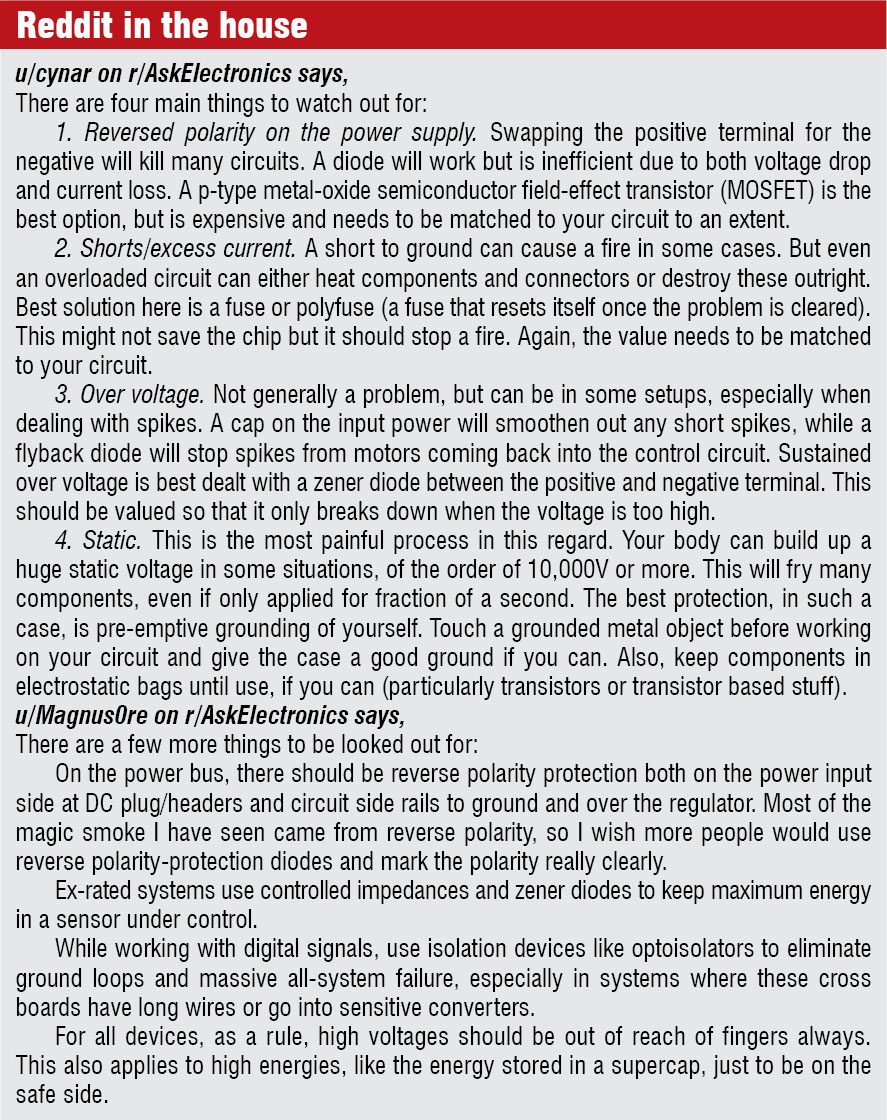Determining whether a circuit is adequately protected can require a high-level view of the electrical distribution system, from the fault current available at the source of supply down to the end device connected to the system. Circuit protection devices fulfil two primary purposes, namely, safety and reliability. Safety is assured by disconnecting the power in a circuit during over current, which eliminates electrocution and fire hazards.
In addition, the right protection may be necessary to comply with agency standards for some end products. Ranging from the classic fuse to schemes for protection against electrostatic discharge (ESD), these solutions are proof that simplicity still produces the best results. Thanks, freakonomics!
You take care of things valuable to you, monetary or otherwise. You may take care of your first love letter the same way a Trekkie would take care of his mint-condition Spock action figure. Closer home, the same level of diligent care is required to protect a small sub-circuit as in protecting a million-dollar sub-station. That is why circuit protection is immensely important (probably the biggest understatement in this article). Companies spend a lot in making sure their investments are safe. After all, what good is a device that does not work long-term or has the temperament of the South African cricket team in World Cup knockout games.

Aspects of circuit protection
If you have watched the movie Interstellar, or are aware of the infamous Murphy’s Law, then you know that, anything (bad) that can happen, will happen. Circuit faults can be generated internally because of problems in the system, or can come from external sources. The basic aim of circuit protection is to safeguard against loss of functionality, or degradation in performance, without affecting the core functionality of the system. It has three key elements: protection against mains voltage and its variations, protection against lightning and high voltage transients, and protection against ESD.
Internal problems can be due to over-current events such as a short circuit, or an overload current, and over-voltage events such as short-duration transient voltage spikes or longer duration over voltages. These faults can negatively impact sensitive electronic circuits, if not dealt with on time. External problems can include lightning interference, that induces surges inside the electronics; these travel from outside conductors on the grid to the inside of buildings and homes.
Most products need all three protection schemes, and the intensity of protection varies according to application. For example, if you are developing telecommunication products, your focus will be on mains and lightning. However, if it is a consumer product, the focus will be on ESD.

Srinivasa Moorthy, director, D4X Technologies Pvt Ltd, says, “Many times designers worry about the protection aspect after the design is complete and find out the problems only when the product fails in compliance tests. The key is to understand the compliance and protection needs. It is usually a matter of deriving protection parameters from the standards and implementing protection as part of the design, not as an afterthought. In my opinion, the most forgotten protection is the protection of communication connectors of the product against ESD.”
Abhinay Patil, field applications manager – key accounts, Analog Devices India, feels that design engineers need to perfect their workflow and not skip any aspects to ensure an optimum protection scheme. He explains, “There are certain international standards that define the tests an electronics system should pass to be certified as an EMI/EMC robust system, something essential to most products made for the consumer market. These tests include ESD, electrical fast transients (EFTs), surge, radio frequency interference (RFI) and others. The design engineer needs to have knowledge of these standards along with the operating conditions of the product, interference sources and mechanisms through which the interference can get coupled into the system, and the impact of the interference on the system.”
Patil adds, “Overlooking any one of these aspects can result in failure to design a truly robust system. Designers also sometimes fail to anticipate non-ideal operating conditions and human errors (like miswirings). So a system that works well in the lab under ideal conditions may fail when installed in the field. Yet another mistake designers may commit is to design the protection scheme only for transient events, while ignoring possible steady state conditions (like high AC/DC voltage on the signal or ground path).”
What is new in this field
Following the trend of going small in electronics, circuit protection has also taken strides in that aspect. New fuse technologies include constructions where voltage ratings and interrupt ratings, that were achievable in larger form factors, are now being implemented in smaller surface-mount devices.
Additionally, in over-voltage protection, surge-handling capabilities of larger metal-oxide varistor products are now being achieved in smaller form factors, and even in surface-mount technologies.
A recent practice is to pack together sub-assemblies of a combination of two protection schemes. Natarajan M.M., vice president for South Asia of Arrow Asia-Pacific, explains, “To overcome electrical over-stress (EoS) and to protect equipment from consequent damage, an innovative solution is brought about by hybrid micro-assemblies, also called integrated product devices, in which two circuit protection devices, usually a combination of over voltage (OV) and over current (OC), are packaged together to provide efficient, cost-effective and space-saving circuit-protection solutions.”
Patil adds, “A digital isolator is a unique ADI product that helps to form an isolation barrier between two sections of the circuit, namely, the low voltage section (very sensitive) and the other side that is facing the field (prone to damage by unwanted signals). A digital isolator prevents unwanted high-potential voltage from affecting the sensitive portion of circuit by creating a barrier. Another impressive technology is our Latch-Up Proof multiplexers (MUXes).”
He continues, “A latch-up is a condition where a low-impedance path is formed between supply and ground, causing excess current to flow, heating up the affected part and eventually burning it out. The MUX or the switch is typically the first element to get exposed in a signal/data-acquisition system, so one of the ways to protect the circuit is to make this MUX as robust as possible. We do this by using a circuit-design technique known as trench isolation.”
Listen up, you
It has been mentioned umpteen times that circuit protection is extremely critical. Let us make that umpteen plus one, with this take by Tim Patel, technical marketing manager, Electronics Business Unit, Littelfuse, “Circuit protection is a critical part of design; it should not be an afterthought. You need to anticipate what faults can occur, what can cause reliability issues, what faults can come into the system that can cause surge events, how a short-circuit event occurs, and what will happen if you do not protect against it. You may need to redo the board layout, costing money and lost development time. You may end up with a less-than-optimal protection device or location, which results in functional failures, poor reliability and safety issues such as shock or fire.”
He adds, “Let me tell you a story. Smartphone and tablet industries have evolved so much that chargers are now directly connected to the wall; the wire is just a USB cable. Any short-circuit condition in wall-mount chargers will come directly from the wall into that charger. It is a very dangerous application if you do not have adequate circuit protection. The charger can explode, catch fire or put the other chargers bundled next to it on fire. To solve this potentially dangerous issue, a very small form factor axial fuse is placed inside wall-mount chargers. This is how changing form factors of end devices force small form factors for protection devices, too.”
Some golden rules to live by
If you have read up to this point, then you need not be told that circuit protection is quite a can of worms. You essentially have to weigh up risk, cost and consequences. In the end, though, you should not mind spending an extra ` 5000 on a circuit that costs Rs. 100,000, as opposed to a circuit that costs Rs. 10,000.
I talked to a host of designers and they all had their own views on what the golden rules are, which must be followed. But within the chaos of opinion, some guidelines did appear a bit more inline than others. Read on to find out if you follow these favourite guidelines of your peers.
According to Moorthy, “Always understand the standards that the product needs to comply with. This is the most significant input for a successful design. Take special care to note the environmental specs, in particular, humidity and altitude. Chances of ESD strikes are higher at low humidity, which can result in complete circuit failure. Increasing chances of lightning at higher altitudes precipitates the need for additional lightning protection to be provided to mitigate the same. I would also suggest working closely with enclosure designers, especially when the enclosure is made of plastic.”
Though nothing beats getting the required results in the lab where everything is hunky dory, there is a difference between theory and practical. If not installed properly, protection can end up damaging the thing it was installed to protect. As is now obvious, only the most thorough understanding of the aspects of circuit protection will be helpful in making your designs safe from all harm. At present rate, adoption of ESD, EMI and other phenomena into circuit-protection tools will soon be complete and early adoption of the miniaturised protection devices can only foster future devices with even longer lives. Long live machines!

Little things to remember about little fuses
In choosing the right fuse for a specific application, you need to know the environment in which the fuse is being used. There are several factors used to select the proper fuse.
One is normal operating current. You need to gauge how much steady-state current is going through the system. A fuse has to operate without unintentionally bursting during the lifetime of the circuit. Fuses can weaken over their lifetimes by temperature cycling and by current that causes heating. This causes incremental stressing of the fuse element and can cause brittleness of alloys. As a result, it can cause destruction of the fuse when it is not supposed to; this is called nuisance tripping.
The second factor is application voltage. Fuses are sensitive to changes in current, not voltage. It is not until the fuse element melts and arcing occurs that the circuit voltage and available power become an issue. A fuse may be used at any voltage that is less than its voltage rating without being detrimental to its fusing characteristics.
The third factor is ambient temperature, which can affect the fuse’s reliability. Current-carrying-capacity tests of fuses are performed at 25°C and will be affected by changes in ambient temperature. The higher the ambient temperature, the hotter the fuse will operate and the shorter its life. Practical experience indicates, fuses at room temperature should last indefinitely, if operated at no more than 75 per cent of the catalogue fuse rating.
The next factor is maximum-fault or short-circuit current, also called interrupt rating or breaking capacity. A fuse must meet or exceed the maximum-fault current of the circuit. The interrupt rating is the maximum current that the fuse can safely interrupt at a rated voltage. During a fault or short-circuit condition, a fuse may be subjected to an instantaneous overload current many times greater than its normal operating current.
Pulses are another factor. Over its lifetime, a fuse can experience inrush currents that happen on startup. Electrical pulses produce thermal cycling and possible mechanical fatigue that could affect the life of the fuse. For some applications, startup pulses are normal and require the use of fuses that incorporate a thermal-delay design to enable these to survive normal startup pulses, while providing protection against prolonged overloads. It is important to define the startup pulse and then compare it to the fuse’s time-current curve.





